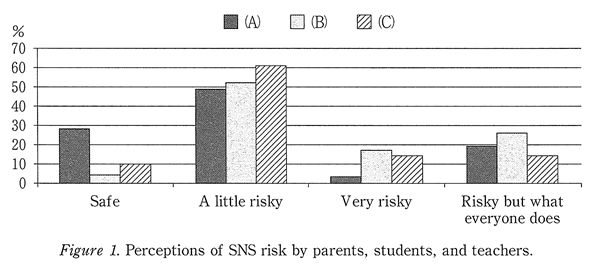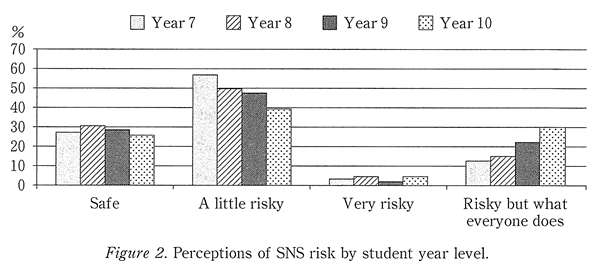問1
問題次の文章はある説明文の一部である。この文章とグラフを読み、下の問いの ( ) に入れるのに最も適当なものを、それぞれ下の1~4のうちから1つずつ選べ。
Social Networking Service (SNS), online services that allow users to communicate with others, are used by a growing number of young people to keep in touch with friends and family. However, this rise in the use of SNS by young people has been accompanied by increasing anxiety among parents and teachers. They are concerned about whether young users are prepared for the risks that come with using SNS, including privacy issues and unwelcome contact.
A 2011 survey asked Australian parents, and teachers about their perceptions of the degree of risk when using SNS─specifically, whether they felt it to be “safe,” “a little risky,” or “risky but what everyone does.” Figure 1 shows that over a quarter of students chose “safe,” in other words, that they felt SNS use was without risk. In addition, 19.6% of students reported that, though they knew the dangers, they still used SNS because that is “what everyone does.” In contrast with the students’ responses, their parents and teachers were more cautious about the risk associated with SNS use, with teachers slightly more likely to see high risk.

問1
In Figure 1, which of following do (A), (B), and (C) refer to?
1. (A) Parents / (B) Students / (C) Teachers
2. (A) Parents / (B) Teachers / (C) Students
3. (A) Students / (B) Parents / (C) Teachers
4. (A) Students / (B) Teachers / (C) Parents
【解説】
Figure 1 の(A)~(C)が「親」「生徒」「先生」のどれを表わしているかを答える問題です。
第二段落の内容を確認しながら、選択肢を絞っていきましょう。
本文にこうあります。
「図1は、学生の4分の1以上が「安全」を選択したことを示しています」
4分の1以上ということは25%以上ということです。図1の Safe で25%をこえているのは(A)だけです。ということでまず(A)が Students だということが分かります。
Students については、さらにこうあります。
「さらに、19.6%の学生は、危険を知っていたとしても、それは「what everyone does」であるため、依然としてSNSを使用していたと報告しました」
図1の Risky but what everyone does を見ると、やはり19.6%なのは(A)です。まぁ、そこまで確認する必要はありませんが、この部分でも(A)が Students であるとわかりますね。
Parents と Teachers に関しては本文にこうあります。
「生徒の回答とは対照的に、両親と教師はSNSの使用に関連するリスクについてより慎重であり、教師はリスクが高いと感じる可能性がわずかに高くなりました」
図1の Very risky を見ると(B)の方が(C)よりもわずかに高くなっています。ということで(B)が Teachers で、残った(C)が Parents になります。
【正解】4
問2
問題次の文章はある説明文の一部である。この文章とグラフを読み、下の問いの ( ) に入れるのに最も適当なものを、それぞれ下の1~4のうちから1つずつ選べ。

Interestingly, not all students had the same perception of risk. Figure 2 shows a comparison between students by year─”Year 7” refers to first-year junior high school students and “Year 10” refers to first-year high school students. While the percentage of students who responded that SNS usage is “safe” was almost the same regardless of year, there was a drop by year in the percentage of students who chose “a little risky,” and a rise in those who chose “risky but what everyone does.”
Furthermore, the study asked students about information security. It found that students from years 7 to 10 were increasingly cautious about privacy, becoming more careful by year about who could see their personal information online. Because Year 7 students, in addition to being the least cautious about information security, also tended to see SNS use as either “safe” or only “a little risky,” they were believed to be at the greatest risk.
問2
Which of the following is mentioned as one of the reasons that Year 7 students are thought to have the highest risk?
1. They are the least careful about security when using SNS.
2. They are the least likely to think SNS is “safe.”
3. They are the most likely to think SNS is “very risky.”
4. They are the most likely to use SNS to contact friends.
【解説】
「7年生が最もリスクが高いと考えられている理由の1つとして、次のうちどれが言及されていますか」
1. They are the least careful about security when using SNS.
「SNSを使用する際のセキュリティについては、最も慎重ではありません」
第4段落に、こうあります。
「7年生は、情報セキュリティに最も注意を払っていないことに加えて、… 彼らは最大の危険にさらされていると考えられていました」
選択肢の the least careful と、本文の the least cautious が対応しています。この選択肢が正解です。
2. They are the least likely to think SNS is “safe.”
「彼らは、SNSが “safe” であると考える可能性が最も低いです」
これは図2の Safe のところを見るといいです。微妙な差ですが、Years 10 の方が低いですよね。
また本文の第4段落にこうあります。
「SNSの使用を “safe” または “little risky” と見なす傾向があった」
さらに常識で考えて、「安全」と考えるのが低いのなら、それは慎重ということですから、リスクは下がるはずです。設問とかみ合いませんね。この選択肢は違います。
3. They are the most likely to think SNS is “very risky.”
「彼らは、SNSが “very risky” であると考える可能性が最も高いです」
これも図2を見るといいです。Very risky のところを見ると、Year 8 や Year 10 よりは少なそうです。
そして常識で考えても、「とても危険」と考えているなら、リスクは下がるはずですから、先ほどの選択肢2 と同様に設問とかみ合いません。この選択肢も違います。
4. They are the most likely to use SNS to contact friends.
「SNSを使用して友達に連絡する可能性が最も高い」
これについては、本文にそういう話はありません。
【正解】1
問3
問題次の文章はある説明文の一部である。この文章とグラフを読み、下の問いの ( ) に入れるのに最も適当なものを、それぞれ下の1~4のうちから1つずつ選べ。
Social Networking Service (SNS), online services that allow users to communicate with others, are used by a growing number of young people to keep in touch with friends and family. However, this rise in the use of SNS by young people has been accompanied by increasing anxiety among parents and teachers. They are concerned about whether young users are prepared for the risks that come with using SNS, including privacy issues and unwelcome contact.
A 2011 survey asked Australian parents, and teachers about their perceptions of the degree of risk when using SNS─specifically, whether they felt it to be “safe,” “a little risky,” or “risky but what everyone does.” Figure 1 shows that over a quarter of students chose “safe,” in other words, that they felt SNS use was without risk. In addition, 19.6% of students reported that, though they knew the dangers, they still used SNS because that is “what everyone does.” In contrast with the students’ responses, their parents and teachers were more cautious about the risk associated with SNS use, with teachers slightly more likely to see high risk.


Interestingly, not all students had the same perception of risk. Figure 2 shows a comparison between students by year─”Year 7” refers to first-year junior high school students and “Year 10” refers to first-year high school students. While the percentage of students who responded that SNS usage is “safe” was almost the same regardless of year, there was a drop by year in the percentage of students who chose “a little risky,” and a rise in those who chose “risky but what everyone does.”
問3
The main purpose of this passage is to ( ).
1. describe the various dangers of using SNS
2. discuss differences in awareness of SNS risk
3. explain why students are using SNS more
4. suggest solutions for the problems with SNS
【解説】
「この文章の主要な目的は( )ことです」
1. describe the various dangers of using SNS
「SNSを使用することのさまざまな危険性について説明する」
第一段落にこうあります。
「彼らは、プライバシーの問題や不愉快な連絡など、SNSの使用に伴うリスクに若いユーザーが備えているかどうかを懸念しています」
しかし、SNSにどのような危険性があるのかに関しては、この第一段落にしか書かれてありません。また以降の段落で、その危険性についての具体的な内容はありません。この選択肢は違います。
2. discuss differences in awareness of SNS risk
「SNSリスクの認識の違いについて議論する」
第二段落とFigure 1 では、「生徒」「先生」「親」それぞれのSNSに対するリスク認識の違いが示されています。
Figure 2 と第三段落では、生徒の学年ごとのSNSに対するリスク認識の違いが示されています。
ということで、この選択肢が正解です。
3. explain why students are using SNS more
「学生がSNSをより多く使用している理由を説明する」
本文の最初にこうあります。
「ソーシャルネットワーキングサービス(SNS)は、ユーザーが他のユーザーとコミュニケーションをとることができるオンラインサービスで、友人や家族と連絡を取り合うためにますます多くの若者が利用しています」
しかし、SNSが使われている理由に触れられているのは、ここくらいです。SNSリスクについての話がその後続きますので、この選択肢は違います。
4. suggest solutions for the problems with SNS
「SNSの問題の解決策を提案する」
解決策については書かれてありません。この選択肢は違います。
【正解】2
問4
問題次の文章はある説明文の一部である。この文章とグラフを読み、下の問いの ( ) に入れるのに最も適当なものを、それぞれ下の1~4のうちから1つずつ選べ。
The study then examined whether adults were discussing SNS risks with young people. However, the results here were not clear. While the study found that over 91% of parents and 68% of teachers said they discuss SNS issues with students, almost half of the students (46.1%) responded they do not talk with their parents, and almost three-quarters of the students (74.6%) responded that they do not talk with teachers. There are several possible explanations for this gap.
(Melissa de Zwart 他(2011) teenagers, Legal Risks & Social Networking Sites を参考に作成)
問4
What topic might follow the last paragraph?
1. Examples of the different risks students face in using SNS
2. Reasons for the different responses from students and adults
3. Trends in how students and adults use the Internet
4. Ways to reduce the number of younger students using SNS
【解説】
「最後の段落に続くトピックは何ですか?」
最後の文はこうなっています。
「このギャップにはいくつかの説明が考えられます」
このギャップに関しての話が、次に続くと考えられます。this gap の this が指す内容は、その前にあります。
「調査では、91%を超える保護者と68%の教師が生徒とSNSの問題について話し合っていると答えましたが、生徒のほぼ半数(46.1%)は、親と話をしないと答え、生徒のほぼ4分の3( 74.6%)は、教師と話をしないと答えました」
生徒の感じ方と、親・先生の感じ方にギャップがあるということですね。それを踏まえて選択肢を確認しましょう。
1. Examples of the different risks students face in using SNS
「学生がSNSを使用する際に直面する、さまざまなリスクの例」
2. Reasons for the different responses from students and adults
「生徒と大人の反応が異なる理由」
3. Trends in how students and adults use the Internet
「学生と大人のインターネット利用の傾向」
4. Ways to reduce the number of younger students using SNS
「SNSを使っている若い学生の数を減らす方法」
親や先生が話し合っているつもりでも、生徒たちはそう感じていないというギャップに関しての話が続くと考えられますから、正解は選択肢2になります。
【正解】2



コメントをどうぞ